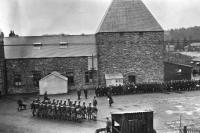Countdown to 2016: Sport in Frongoch
Published in 20th-century / Contemporary History, Issue 4 (July/August 2012), Reviews, Revolutionary Period 1912-23, Volume 20
Inside Frongoch internment camp in 1916.
In January 1914 James Nowlan, president of the GAA, advised every member to join the Irish Volunteers and ‘learn to shoot straight’. Nowlan took his own advice and, as a member of the Volunteers, was imprisoned in Frongoch internment camp following the Easter Rising. As a prisoner, he was among many who engaged in sporting competitions at the camp—an important means not only of blowing off steam but also of fostering camaraderie among men who were to become the leaders of the IRA in the War of Independence, as well as many who were later to become TDs.Frongoch held hundreds of GAA members and Gaelic football was a major activity among the prisoners. Hurling was outlawed, as the British camp commandant banned hurleys, fearing that they would be used as weapons against the guards. The football pitch in Frongoch was called ‘Croke Park’ after the stadium in Dublin, and posters advertising the matches indicated that ‘admission was to be 5 shillings, and wives and sweethearts should be left at home’.Dick Fitzgerald of Killarney, who captained Kerry to two all-Ireland victories, was one of the chief organisers. Frank Burke was a teacher at St Enda’s and won all-Ireland medals in both football and hurling. Others who had competed for their county teams were Frank Shouldice (Dublin), Paddy Cahill (Kerry), Brian Joyce (Dublin) and Seamus Dobbyn (Antrim).Often two games of football were played daily, and three teams were fielded from the south camp and one from the north camp. While two of the teams from the south camp were composed of accomplished players, the third team, led by Fitzpatrick and nicknamed the ‘Leprechauns’, were supposedly not so accomplished. But in the round-robin tournament the Leprechauns beat the other south camp teams and went on to beat the north camp team in the finals. The guards watched in bemusement and were greatly impressed with the roughness of the games. One guard was heard to observe: ‘If this is what they’re like at play, they must be hellish in a scrap!’It has been claimed that rugby was played at Frongoch, and a rugby ball from the prison has been displayed at the National Museum in Dublin, but most accounts are adamant that only Gaelic games and athletics were played in the camp. It seems more likely that a rugby ball was used in playing Gaelic football: given the dominance of rugby in Wales, oval balls were more readily available than round ones.The chief sporting occasion in Frongoch was the athletics day on 8 August 1916. The 100yds dash, shot-put and 56lb throw were the principal events. Michael Collins won the 100yds dash, a victory that contributed mightily to the Collins mythology. M.W. O’Reilly, prisoner commandant of the north camp, was winning easily until Collins overtook him in the last few strides. Some said that Collins grabbed O’Reilly’s shirt as he passed him, but all seem to agree that Collins taunted O’Reilly, saying ‘Ah, ya hoor, you can’t run’. Collins’s winning time was recorded as just under eleven seconds, an accomplishment that was quoted in the House of Commons to refute any charges that the prisoners were undernourished. Major R.P. Newman gave Collins’s time as 10? seconds, but Collins took pains to correct that in a letter to his sister Hannie, claiming that the actual time was 104/5 seconds.In an event unique to Frongoch, Seán Hales, the Munster shot-put champion, was able to throw a 56lb weight over a bar. Collins finished second, and Joe Good wrote that later that night he found Collins throwing the weight again and again until he matched the winning throw. Séamus Ó Maoileóin commented: ‘There was never half as much spirit, fun and energy seen in the all-Ireland finals as that which was displayed at Frongoch’. HI
Joseph E. Connell is the author of Dublin in rebellion: a directory, 1913–1923 (Lilliput Press, 2006).
















